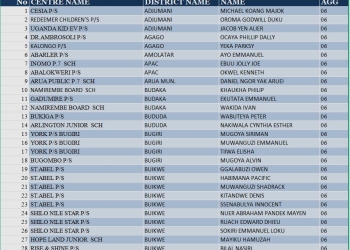
The Angololo Water Resources Development Project (AWDP) is a transformative $137 million cross-border initiative jointly launched by the Governments of Kenya and Uganda through the Nile Basin Initiative (NBI), under the technical coordination of its Nile Equatorial Lakes Subsidiary Action Program Coordination Unit (NELSAP-CU). Located within the shared Sio-Malaba-Malakisi (SMM) River Basin in the Lake Victoria sub-basin, the project aims to improve water resource management, boost agricultural productivity, increase energy access, and strengthen climate resilience in a region highly dependent on natural resources for livelihoods.
With financing from the African Development Bank (AfDB) and the NEPAD-IPPF Special Fund, the project is set to directly benefit over 300,000 people in Busia and Bungoma Counties (Kenya) and Tororo, Namisindwa, and Manafwa Districts (Uganda). It features a 40-metre-high dam with a 31.6 million cubic metre reservoir, a 1.3 MW mini-hydropower plant with plans to integrate 20 MW of floating solar, a 4,000-hectare irrigation scheme, and water supply systems for both domestic and livestock use. Additional components include watershed restoration, flood control, and fisheries and aquaculture initiatives to enhance food security and community resilience.
Originally identified in 2010 under the SMM River Basin Management Project, the Angololo initiative has undergone rigorous feasibility assessments and stakeholder consultations coordinated by NELSAP. The preparatory phase, funded by the governments of Sweden and Norway, culminated in the project’s inclusion in AfDB’s operational pipeline and a bilateral agreement between Kenya and Uganda to jointly implement the project.
This interview with Dr Isaac Alukwe, Regional Coordinator at NELSAP-CU, offers crucial insights into the implementation strategy, regional cooperation framework, and long-term impact of the project. Under his leadership, NELSAP has ensured alignment with both Kenya’s Vision 2030 and Uganda’s Vision 2040, while maintaining strong engagement with communities, local governments, and national institutions.
As Dr Alukwe notes, “This project is not just about infrastructure, it’s about empowering people and transforming communities.” The Angololo Project stands as a flagship model for transboundary cooperation, regional integration, and inclusive development in the Nile Basin.
What does today’s signing symbolise for the future of transboundary water cooperation between Kenya and Uganda?
Uganda and Kenya have previously collaborated in various sectors like trade, but the signing of the Angololo bilateral agreement marks a significant milestone. It represents one of the first major infrastructure projects jointly implemented by the two countries. This is a clear sign of deepening cooperation and integration, a strong commitment that reflects growing friendship between the nations.
How will NELSAP-CU ensure timely implementation and accountability of this $137 million project?
The financing arrangements are made between the financiers and the countries, while NELSAP has been mandated to coordinate implementation of the shared infrastructure components. National-level components such as irrigation will be implemented by each country individually. The pace of implementation depends on how quickly the countries finalise financing instruments and meet associated requirements. Once financing is secured, NELSAP has a strong track record of adhering to project timelines, as demonstrated in past initiatives like the LEAF II project between the DRC and Uganda.
How does the project integrate climate resilience and sustainable development principles?
The Angololo Multi-Purpose Dam is what we call a ‘climate-proofed’ project. Its design incorporates standards and guidelines that ensure resilience to climate variability. It also includes the restoration of a 447 km² catchment area, which is a major intervention for climate change mitigation. In addition, a livelihood support programme is built into the project to help communities adapt and build resilience.
What lessons from past transboundary projects are being applied to avoid delays or disputes?
The speed of implementation often reflects how high a project ranks in national priorities. In this case, both countries have shown strong commitment. Uganda has submitted a formal financing request to the African Development Bank and included the project in its upcoming budget. Kenya’s Cabinet approved the project in early 2024 and also plans to fund it in the next financial year. While NELSAP coordinates implementation, the project’s strategic direction comes from a bilateral steering committee composed of both countries. This governance model helps ensure coordination, oversight, and timely decision-making.
How does NELSAP plan to ensure that the benefits of the Angololo Project reach the most vulnerable groups, especially women, youth, and persons with disabilities?
Inclusivity is a core priority at NELSAP. We ensure gender representation across all activities, whether in employment, training, or decision-making roles. Every project requires that at least a third of participants represent a particular gender. The Angololo Project includes targeted capacity-building initiatives for both men and women, with specific quotas to ensure equal participation in all stages of project implementation.
What specific climate adaptation strategies have been integrated into the project to address increasing rainfall and temperature variability across the Sio-Malaba-Malakisi basin?
The project integrates a wide range of resilience-building measures tailored to local conditions. These include aquaculture, fish farming, and livestock watering points. Additionally, crops to be grown under the irrigation scheme have been selected for their climate resilience. These initiatives will strengthen communities’ ability to adapt to variability in climate across the basin.
How does NELSAP-CU plan to involve local journalists and community media in monitoring and reporting the project’s progress and impact?
That’s why we’re investing in journalist training. It’s critical that the media has access to accurate, verified information about our projects. We make ourselves available for verification and provide updates during field visits and engagements. This approach supports transparency and ensures communities remain informed and involved.
Given the project’s cross-border nature, how will conflict resolution and governance be handled between Kenya and Uganda?
The bilateral agreement includes specific clauses that outline procedures for handling disputes. These include arbitration mechanisms and recourse to institutions such as the East African Court of Justice. These provisions provide a clear framework for addressing any governance challenges that may arise during joint implementation.
What long-term strategies are in place to ensure sustainability of infrastructure like the irrigation scheme and hydropower plant once donor funding ends?
The project is designed to be self-sustaining. For example, irrigation cooperatives will be formed to help farmers manage production and market access. Aquaculture and related initiatives will economically empower local communities. Additionally, a Special Purpose Vehicle (SPV), a company jointly owned by both countries, will be created to manage operations. This SPV will be funded by project revenues and national contributions to ensure long-term operation and maintenance.
Will data collected from the project on irrigation, energy use, environmental impact, etc. be made accessible to researchers, journalists, or the public?
Each country has its own legal frameworks governing data access and sharing. Relevant national agencies like environmental authorities and water resource regulators are involved in project governance. These agencies have access to project data and will share it according to their respective national regulations. The Environmental and Social Impact Assessment (ESIA) reports, for instance, are reviewed and approved by the relevant authorities in both countries.

















